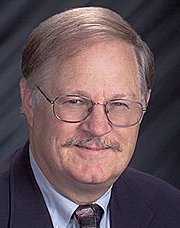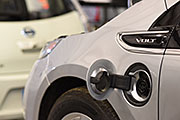If you've ever been truly curious about something, you know that getting the answer isn't the end. It's just the beginning. Answers lead to action, to seeing if you can apply what you’ve learned to make a difference. Dick Kouzes, a noted physicist at DOE’s Pacific Northwest National Laboratory, knows by heart. For 40 years, he's tackled difficult questions about how the universe works and applied that knowledge to create better ways to detect illicit nuclear materials, find carbon dioxide leaks, and teach the nuances of physics to poets.
At Princeton University in New Jersey, where he graduated with a doctoral degree in physics and later served as a Senior Research Physicist and Lecturer, he delved into neutrino detection. Neutrinos are the byproduct of the reactions that occur at the heart of the Sun and other stars. The neutrinos, which are smaller than atoms and travel at near the speed of light, flow through us and our planet. Dick wanted to know why the number of neutrinos measured by detectors and that predicted by computational models didn't agree.
Full Story
Feature
While America’s love affair with the internal combustion engine is not showing any signs of slowing down, plug-in electric vehicles are finding their way into the marketplace. But the big question is, “What is it going to take to see plug-in electric vehicles embraced by the public?” To give automakers, government planners and the public an idea, at DOE's Idaho National Laboratory has released the most comprehensive study to date on plug-in vehicle usage and charging patterns.
Drawing data from five different projects between early 2011 and the beginning of 2014, study partners installed more than 17,000 charging stations around the country and tracked the charging habits of more than 8,000 plug-in hybrid and all-electric car drivers. EV owners and businesses were given incentives to participate, with DOE installing Level 2 chargers in homes and company parking lots wherever it could obtain written consent to monitor use over three years.
Full Story
See also…
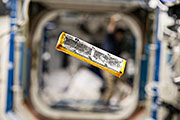 A synthetic muscle experiment on board the International Space Station (ISS) that was developed with the help of Princeton Plasma Physicists Laboratory scientists is now tentatively scheduled to return to earth in March of 2016 on a new SpaceX-10 rocket. It would be returning eight months later than originally planned after an unmanned SpaceX Falcon 9 rocket headed for the ISS exploded a few minutes after liftoff in late June.
A synthetic muscle experiment on board the International Space Station (ISS) that was developed with the help of Princeton Plasma Physicists Laboratory scientists is now tentatively scheduled to return to earth in March of 2016 on a new SpaceX-10 rocket. It would be returning eight months later than originally planned after an unmanned SpaceX Falcon 9 rocket headed for the ISS exploded a few minutes after liftoff in late June.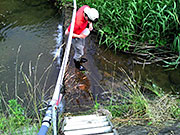 Researchers at DOE's Savannah River National Laboratory are collaborating with scientists in Japan to help find ways to remediate environmental areas contaminated by the Fukushima disaster. As part of this effort, they also hope to learn more about how radionuclides migrate through the environment to improve our ability to more accurately predict risk associated by radiological releases. The three-year joint project will focus primarily on the movement of plutonium and radioiodine.
Researchers at DOE's Savannah River National Laboratory are collaborating with scientists in Japan to help find ways to remediate environmental areas contaminated by the Fukushima disaster. As part of this effort, they also hope to learn more about how radionuclides migrate through the environment to improve our ability to more accurately predict risk associated by radiological releases. The three-year joint project will focus primarily on the movement of plutonium and radioiodine.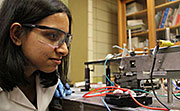 When it comes to lighting, LEDs – light-emitting diodes – grab the headlines for energy efficiency and longevity. But for other applications where the light needed falls near the invisible part of the spectrum, a different type of diode may provide the solution. DOE's Ames Laboratory has developed a near ultra-violet and all-organic light emitting diode (OLED) that can be used as an on-chip photosensor.
When it comes to lighting, LEDs – light-emitting diodes – grab the headlines for energy efficiency and longevity. But for other applications where the light needed falls near the invisible part of the spectrum, a different type of diode may provide the solution. DOE's Ames Laboratory has developed a near ultra-violet and all-organic light emitting diode (OLED) that can be used as an on-chip photosensor.